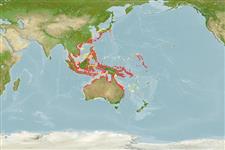Common names from other countries
Classification / Names / Names
Namen | Synonyme | Catalog of Fishes (gen., sp.) | ITIS | CoL | WoRMS
Environment: milieu / climate zone / depth range / distribution range
Ökologie
; tiefenbereich 0 - 20 m (Ref. 343). Tropical
Indo-Pacific: Southeast Asia to Fiji and New Hebrides.
Length at first maturity / Size / Gewicht / Alter
Maturity: Lm ?, range 3 - 4.46 cm Max length : 5.0 cm CW Männchen/unbestimmt; (Ref. 343)
Carapace rounded, with 2 long, well-developed lateral spines; anterolateral margins gently serrated. Outer surface of palm with low but distinct oblique ridge. Color: yellowish ground color with numerous fine black spots and several larger ones on carapace; legs and chelae bright yellow.
Caught by local communities in nets, by hand or beach seines. On sandy areas (Ref. 343), and intertidal mudflats (Refs. 128960, 9773). Carnivorous and facultative scavengers. Preys mainly on crustaceans and mollusks; smaller individuals on small, soft-shelled species while larger individuals eat slow-moving invertebrates like anomurans, bivalves and gastropods (Ref. 102715). Scavenger-predator (Ref. 128960). Usually seen swimming along the tidal current. Known to burrow in sand (Ref. 9773).
Members of the order Decapoda are mostly gonochoric. Mating behavior: Precopulatory courtship ritual is common (through olfactory and tactile cues); usually indirect sperm transfer.
Ng, P.K.L. 1998. (Ref. 343)
IUCN Rote Liste Status (Ref. 130435)
CITES Status (Ref. 108899)
Not Evaluated
Not Evaluated
Bedrohung für Menschen
Harmless
Nutzung durch Menschen
Fischereien: kleinfischerei
| FishSource |
Tools
Internet Quellen
Estimates based on models
Preferred temperature
(Ref.
115969): 22.8 - 29.3, mean 28.6 (based on 2487 cells).
Verwundbarkeit
Low vulnerability (10 of 100).
Preiskategorie
Unknown.
